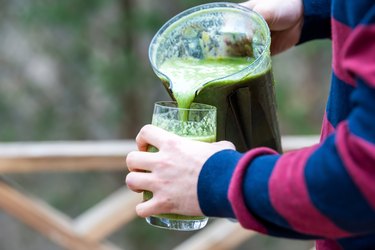
If you like the idea of eating your vegetables on the run, a little preparation ahead of time goes a long way. Instead of buying a pricey juicer, turning your blender into a juice blender may provide a healthy drink without breaking the wallet.
Tip
To keep your juice from discoloring during storage, add a teaspoon or two of fresh lemon juice to it.
Video of the Day
Juice Blender: Juice or Smoothie?
Making juice in a blender is more work than using a juicer. A regular blender can turn fruits and vegetables into liquid, although it will be a bit thicker than what you'd get from a juicer. It's best to use watery fruit and vegetables for this purpose, like cucumbers, tomatoes, celery, apples, pears and watermelon, along with easy-to-chop veggies like spinach and chard.
Video of the Day
When making juice in a blender, you'll need to cut your veggies smaller than you'd need to for a juicer. You will also get some chunks that you may want to skim off to get a liquid concoction. If you don't mind those, you'll get more nutrients in your beverage, according to the University of Washington.
Fruits and vegetables are full of fiber, phytonutrients and other bioactive compounds. When using a blender for juicing, the resulting thick liquid will preserve some of the fiber and nutrients unless you strain it out, notes the Mayo Clinic. This fiber-rich drink will make you feel fuller and improve the digestive process.
Read more: 10 Ultimate Smoothies for Any Time of Day
Blending Fruits and Veggies
A thick juice or smoothie has more fiber and nutrients than a thin one. For a thick texture, use an immersion blender. If you want silkier results, a high-powered upright blender is the best option. Some pointers from the University of Washington on juicing with a blender include:
- Green veggies like kale, spinach, parsley and cabbage surprisingly don't taste very intense in smoothies or juice, so load up on those.
- Citrus juices, especially lime juice, can help to cut out any bitter taste from vegetables (remember to remove the peels).
- When juicing, high-water vegetables like cucumbers and celery will help to add volume and nutrients.
- When blending smoothies, add regular water or coconut water to make it less pulpy.
The University of Washington suggests that a high-quality blender is more versatile than a juicer. So, if you're thinking, "What's the best juicer?" and you only have room or budget for one or the other, a high-powered blender is the way to go.
Read more: 10 Irresistible Weight Loss Smoothie Recipes
Nutrition From Juice Blending
If you extract the fiber from your juice, you won't get all the nutritional benefits you'd get if you left the fiber in, points out the Mayo Clinic. For example, according to Harvard Health Publishing, apple juice has significantly fewer vitamins, minerals and antioxidants than whole apples. Juices are also more concentrated in calories and sugar, which may lead to weight gain and increase the risk of developing diabetes.
If you're looking to increase your intake of fruits and vegetables, juices do have some benefits. For example, kale juice may improve lipid levels, which will help with your cholesterol levels, states Harvard Health Publishing. Citrus-based juices may reduce heart disease risk. They also contain key nutrients, such as vitamin C. However, more research is needed to identify the health benefits and safety of juicing.
Our delicious Everyday Green Smoothie contains kale, while our recipe for this Vegan Hint-of-Sweet Avocado Shake features green juice ingredients like avocado and spinach. You might also like to try our Green Superfood Smoothie Jar, which is made with cucumbers, baby spinach and broccoli.
The best part is, all of these can be made with a blender, offering 6 grams of fiber per serving. Dietary fiber adds bulk to your diet and promotes satiety, which in turn, makes it easier to control your weight and stay regular, states the U.S. National Library of Medicine.